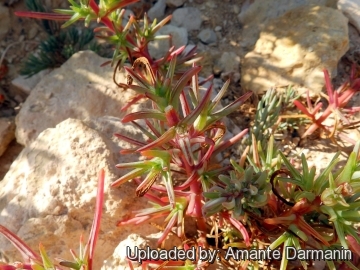Accepted Scientific Name: Salsola soda L.
Sp. Pl. 223 1753. L.

Kali soda (Salsola soda) Photo by: Amante Darmanin
San Anard, Malta, 4 July 2016
Origin and Habitat: Salsola sodaSN|34223]]SN|34223]] grows abundantly on the shores of the Mediterranean Basin and. has a wide Eurasian and African distribution. It has also been introduced in South America and USA (California).
Altitude range: 0–50 metres above sea level.
Habitat and ecology: Salsola sodaSN|34223]]SN|34223]] is a halophyte (a salt-tolerant plant) that typically grows in coastal saline habitats and can be irrigated with salt water. It also appear in inland regions.
Synonyms:
See all synonyms of Salsola soda
back
Accepted name in llifle Database:Salsola soda L.Sp. Pl. 223 1753.Synonymy: 4
back
Common Names include:
ENGLISH: Salt Wort, salsola, barilla plant, oppositeleaf Russian thistle, opposite-leaved saltwort, glass-wort, Fleshy-leaved Russian-thistle, sea spinach, French saltwort
DUTCH (Nederlands): soda kruid
FRENCH (Français): soude commune, herbe au verre, salsola soda
GERMAN (Deutsch): Soda-Salzicraut
ITALIAN (Italiano): lischeri, Barba del Negus, agretti, Barba di frate, bacicci, roscano, lischi, liscari sativa
MALTESE (Malti): haxixa tar-nniet
NORWEGIAN (Bokmål): sodaurt
POLISH ( Polski): solanka sodowa
PORTUGUESE (Português): salsola
ROMAGNOL DIALECT (Rumagnòl): lischi, liscari
SPANISH (Español): barilla, peralejo
Description: Salsola sodaSN|34223]]SN|34223]], more commonly known in English as opposite-leaved saltwort or barilla plant, is a fleshy, hairless, rounded shrub that has a perennial root. Its stem rises with herbaceous stalks from 5 to 70 cm high these are without thorns and of a reddish brown colour. The plant don't becoming a tumbleweed. The greyish-green, often becoming reddish, leaves clasping the stem. The leaves on principal stalk and those on the lower part of branches are long slender and have no spines on the upper part of the stalk and branches are slender short and crooked. The flowers grow singly at the insertion of the leaves they are very small and followed by capsules each of which contains only one seed. The plant has great historical importance as a source of soda ash, which was extracted from the ashes of Salsola sodaSN|34223]]SN|34223]] and other saltwort plants. While the era of farming for soda ash is long past, Salsola sodaSN|34223]]SN|34223]] is still cultivated as a vegetable that enjoys considerable popularity in Italy and with gourmets around the world.
Stems: Erect or ascending, branched from base or nearly so; branches straight or slightly arcuate (proximal ones sometimes almost prostrate) neither ridged, nor red striped, nor hairy.
Leaves: (especially proximal ones) mostly opposite, straight and thick adhering to the stem. Blade linear, awl shaped, widened at the base, usually more than 1.5 mm wide, fleshy, triangular in cross section, distinctly swollen or ovate at base, apex mucronulate, not spinose. Green to ash-coloured, with two opposite longitudinal streaks, often becoming reddish, the margin of base membranous and diaphanous.
Inflorescences: Axillary. Distinctly interrupted, 1-flowered; bracts alternate or almost opposite, not imbricate, horizontally reflexed at maturity, swollen at base, abruptly narrowing into mucronulate nonspinose apex.
Flowers: The flowers grow singly at the insertion of the leaves, the bracteoles are distinct, not fused to perianth segments. The perianth segments are wingless or with rudimental triangular tubercles at maturity, the margins are crenate or pectinate-ciliate apically, glabrous.
Fruits (capsules): ca. 3–6(–7) mm in diameter, each of containing only one cochleated seed
Chromosome number: 2n = 18.
Bibliography: Major refernces
1) George Gregory “A New and Complete Dictionary of Arts and Sciences: Including the Latest Improvement and Discovery and the Present States of Every Branch of Human Knowledge”, Volume 3 Collins and Company, 1819
2) Sergei L. Mosyakin “Flora of North America”, FNA | Family List | FNA Vol. 4 | Chenopodiaceae. Retrieved fromhttp://www.efloras.org/florataxon.aspx?flora_id=1&taxon_id=129079
3) Wikipedia contributors. "Salsola soda." Wikipedia, The Free Encyclopedia. Wikipedia, The Free Encyclopedia, 5 Feb. 2017. Web. 25 Jun. 2017
4) Stanley J. Kays “Cultivated Vegetables of the World: A Multilingual Onomasticon” Springer Science & Business Media, 2011
5) Alex Casha “Flora of the Maltese Islands” Lulu Enterprises Incorporated, 18 July 2015
6) John Wilkes “Encyclopaedia Londinensis”, Volume 22 1827
7) Charles Knight “Vegetable substances: materials of manufactures” 1833
 Salsola soda. San Anard 4 July 2016 (Salsola soda) Photo by: Amante Darmanin
Salsola soda. San Anard 4 July 2016 (Salsola soda) Photo by: Amante Darmanin Salsola soda. San Anard, Malta, 4 July 2016 (Salsola soda) Photo by: Amante Darmanin
Salsola soda. San Anard, Malta, 4 July 2016 (Salsola soda) Photo by: Amante Darmanin












